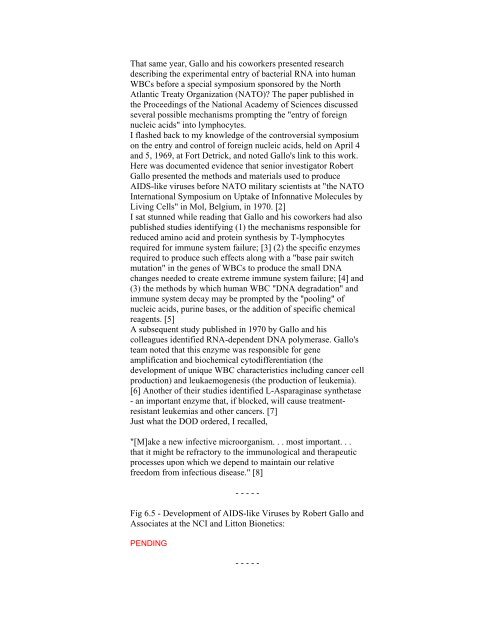Emerging Viruses-Aids & Ebola - By Leanard ... - preterhuman.net
Emerging Viruses-Aids & Ebola - By Leanard ... - preterhuman.net
Emerging Viruses-Aids & Ebola - By Leanard ... - preterhuman.net
You also want an ePaper? Increase the reach of your titles
YUMPU automatically turns print PDFs into web optimized ePapers that Google loves.
That same year, Gallo and his coworkers presented researchdescribing the experimental entry of bacterial RNA into humanWBCs before a special symposium sponsored by the NorthAtlantic Treaty Organization (NATO)? The paper published inthe Proceedings of the National Academy of Sciences discussedseveral possible mechanisms prompting the "entry of foreignnucleic acids" into lymphocytes.I flashed back to my knowledge of the controversial symposiumon the entry and control of foreign nucleic acids, held on April 4and 5, 1969, at Fort Detrick, and noted Gallo's link to this work.Here was documented evidence that senior investigator RobertGallo presented the methods and materials used to produceAIDS-like viruses before NATO military scientists at "the NATOInternational Symposium on Uptake of Infonnative Molecules byLiving Cells" in Mol, Belgium, in 1970. [2]I sat stunned while reading that Gallo and his coworkers had alsopublished studies identifying (1) the mechanisms responsible forreduced amino acid and protein synthesis by T-lymphocytesrequired for immune system failure; [3] (2) the specific enzymesrequired to produce such effects along with a "base pair switchmutation" in the genes of WBCs to produce the small DNAchanges needed to create extreme immune system failure; [4] and(3) the methods by which human WBC "DNA degradation" andimmune system decay may be prompted by the "pooling" ofnucleic acids, purine bases, or the addition of specific chemicalreagents. [5]A subsequent study published in 1970 by Gallo and hiscolleagues identified RNA-dependent DNA polymerase. Gallo'steam noted that this enzyme was responsible for geneamplification and biochemical cytodifferentiation (thedevelopment of unique WBC characteristics including cancer cellproduction) and leukaemogenesis (the production of leukemia).[6] Another of their studies identified L-Asparaginase synthetase- an important enzyme that, if blocked, will cause treatmentresistantleukemias and other cancers. [7]Just what the DOD ordered, I recalled,"[M]ake a new infective microorganism. . . most important. . .that it might be refractory to the immunological and therapeuticprocesses upon which we depend to maintain our relativefreedom from infectious disease." [8]- - - - -Fig 6.5 - Development of AIDS-like <strong>Viruses</strong> by Robert Gallo andAssociates at the NCI and Litton Bio<strong>net</strong>ics:PENDING- - - - -








![The Big Lie 9-11 and Government Complicity in Mass Murder [PDF]](https://img.yumpu.com/50957077/1/190x245/the-big-lie-9-11-and-government-complicity-in-mass-murder-pdf.jpg?quality=85)







